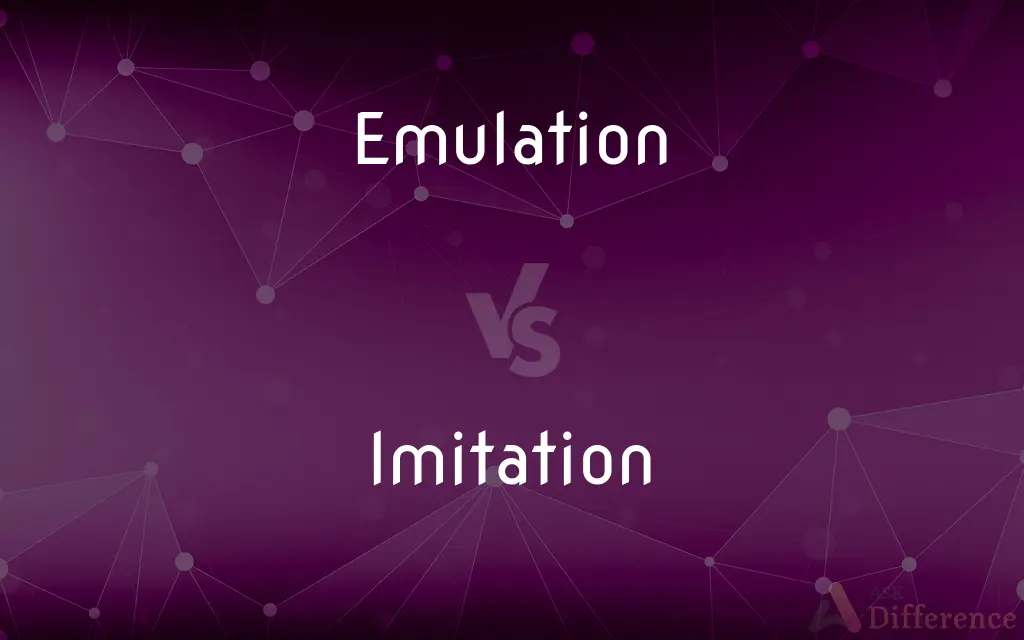Emulation vs. Imitation — What's the Difference?
Edited by Tayyaba Rehman — By Urooj Arif — Updated on April 20, 2024
Emulation involves striving to equal or surpass an original, often motivated by admiration, whereas imitation is simply copying behavior, style, or actions without necessarily understanding or surpassing the original.

Difference Between Emulation and Imitation
Table of Contents
ADVERTISEMENT
Key Differences
Emulation is a process where individuals or systems attempt to reach or exceed the standards set by a model or example, often driven by respect and aspiration. On the other hand, imitation refers to the straightforward replication of another's actions or creations, typically without the underlying drive to excel or innovate.
In emulation, the goal is not just to replicate but to understand and possibly improve upon the original. This involves a deeper level of engagement and analysis, whereas imitation might not require such depth, focusing more on the surface level reproduction of observable traits or outputs.
Emulators often use the achievements of their models as a benchmark to surpass, thereby pushing boundaries in their fields. Conversely, imitators may seek to replicate success without necessarily contributing to progress or adding original value.
While emulation can lead to innovation and personal or technological advancements, imitation is more about maintaining status quo, learning, or assimilation without necessarily leading to significant changes or improvements.
Emulation is typically seen in a positive light, as it encourages growth and excellence. In contrast, imitation can have either a neutral or negative connotation, depending on whether it’s seen as a form of flattery or as a lack of originality.
ADVERTISEMENT
Comparison Chart
Objective
Surpass the original's achievements
Copy the original's characteristics
Motivation
Admiration and aspiration
Convenience or learning
Level of Engagement
Deep and analytical
Superficial and observational
Outcome
Innovation and improvement
Reproduction without change
Connotation
Generally positive
Can be neutral or negative
Compare with Definitions
Emulation
Striving to match or exceed something.
He approached his studies with emulation, aiming to surpass his mentor’s accomplishments.
Imitation
Reproducing someone’s behavior or work.
The child’s imitation of her teacher was endearing.
Emulation
Using technology to replicate another system.
Software emulation allows a PC to run Mac programs.
Imitation
Artificial or synthetic reproduction.
The jacket was made from imitation leather.
Emulation
Admirable effort to equal a role model.
Her emulation of the company’s founder inspired a new corporate culture.
Imitation
Mimicry used for entertainment or practice.
His imitation of famous singers won him the talent show.
Emulation
Mimicking with the intent to surpass.
The young artist's emulation of classical masters shows in his sophisticated technique.
Imitation
Utilizing existing models as templates.
Her writing style is an imitation of her favorite author.
Emulation
Aspiring towards excellence by following an example.
His emulation of historical leaders shaped his political strategies.
Imitation
Copying methods or styles from others.
The building’s design was a clear imitation of modernist architecture.
Emulation
To strive to equal or excel, especially through imitation
An older pupil whose accomplishments and style I emulated.
Imitation
Imitation (from Latin imitatio, "a copying, imitation") is an advanced behavior whereby an individual observes and replicates another's behavior. Imitation is also a form of social learning that leads to the "development of traditions, and ultimately our culture.
Emulation
To compete with successfully; approach or attain equality with.
Imitation
The act or an instance of imitating
Gave us his imitation of a famous actor.
Emulation
(Computers) To imitate the function of (another system), as by modifications to hardware or software that allow the imitating system to accept the same data, execute the same programs, and achieve the same results as the imitated system.
Imitation
Something derived or copied from an original, often in an inferior way
An undrinkable imitation of real lemonade.
Emulation
The endeavor or desire to equal or excel someone else in qualities or actions.
A great figure who is worthy of respect and emulation
Imitation
Repetition of a phrase or melody often with variations in key, rhythm, and voice.
Emulation
(obsolete) Jealous rivalry; envy; envious contention.
Imitation
Repetition of a theme in another voice such that each part continues polyphonously.
Emulation
(computing) Execution of a program or other software designed for a different system, by simulating parts of the other system.
Imitation
Made to resemble another, usually superior material
Imitation fur.
Emulation
The endeavor to equal or to excel another in qualities or actions; an assiduous striving to equal or excel another; rivalry.
A noble emulation heats your breast.
Imitation
The act of imitating.
Emulation
Jealous rivalry; envy; envious contention.
Such factious emulations shall arise.
Imitation
A copy or simulation; something that is not the real thing.
Imitation leather
Emulation
Imitation (of an admired model) for the purpose of improving one's own qualities.
[Chivalry was] an ideal which, if never met with in real life, was acknowledged by all as the highest model for emulation.
Imitation
The act of imitating.
Poesy is an art of imitation, . . . that is to say, a representing, counterfeiting, or figuring forth.
Emulation
The imitation of the actions of a computer system or component, especially a processor, by means of a computer program, with the goal of predicting the behavior and performance characteristics of that system without actually manufacturing it.
1996 marked the year that emulation became a mainstream design verification tool.
Imitation
That which is made or produced as a copy; that which is made to resemble something else, whether for laudable or for fraudulent purposes; likeness; resemblance.
Both these arts are not only true imitations of nature, but of the best nature.
Emulation
Ambition to equal or excel
Imitation
One of the principal means of securing unity and consistency in polyphonic composition; the repetition of essentially the same melodic theme, phrase, or motive, on different degrees of pitch, by one or more of the other parts of voises. Cf. Canon.
Emulation
(computer science) technique of one machine obtaining the same results as another
Imitation
The doctrine that representations of nature or human behavior should be accurate imitations
Emulation
Effort to equal or surpass another
Imitation
A copy that is represented as the original
Imitation
Copying (or trying to copy) the actions of someone else
Imitation
A representation of a person that is exaggerated for comic effect
Imitation
Not genuine or real; being an imitation of the genuine article;
It isn't fake anything; it's real synthetic fur
Faux pearls
False teeth
Decorated with imitation palm leaves
A purse of simulated alligator hide
Common Curiosities
Why might someone choose imitation over emulation?
Imitation can be easier and quicker, suitable for situations where exact replication is needed or when innovation is not a priority.
What drives someone to emulate?
Emulation is driven by admiration and the aspiration to meet or surpass a standard.
How does imitation differ from emulation in terms of learning?
Imitation involves copying to learn or integrate, without the higher goal of improvement that characterizes emulation.
Can imitation lead to legal issues?
Yes, imitation can lead to legal issues, particularly when it involves copyright infringement or the unauthorized replication of proprietary products or designs.
How do emulation and imitation differ in artistic contexts?
In art, emulation often involves artists drawing inspiration from predecessors to create work that pushes creative boundaries, whereas imitation might involve directly copying another artist’s style or work without transformative or interpretative elements.
What are the risks of relying too heavily on imitation in business?
Relying too heavily on imitation can stifle creativity and innovation within a business, potentially leading to stagnation and a lack of competitive edge.
Can emulation lead to innovation?
Yes, by surpassing the original, emulation often leads to innovation and advancements.
Is imitation always a negative approach?
Not necessarily; imitation can be a useful learning tool or form of flattery, though it may be viewed negatively if it stifles creativity.
Is emulation considered ethical in the business world?
Emulation is generally seen as ethical in business, as it involves striving for excellence and improving upon existing ideas, which encourages competition and innovation.
What role does imitation play in language learning?
Imitation is crucial in language learning, enabling learners to acquire pronunciation, intonation, and linguistic structures by mimicking native speakers.
How can emulation be beneficial in academic settings?
Emulation can drive students to achieve higher standards and foster a competitive yet constructive environment by encouraging them to aspire to the accomplishments of their peers or role models.
What are some practical examples of emulation in technology?
In technology, emulation commonly refers to software or devices that imitate another system, enabling one computer system to behave like another.
How does imitation play a role in early childhood development?
Imitation is fundamental in early childhood development, allowing children to learn skills and social behaviors by observing and copying adults and peers.
How do cultures differ in their appreciation of imitation and emulation?
Cultural appreciation of imitation and emulation can vary; some cultures value innovation and originality, thus favoring emulation, while others might respect tradition and mastery of established methods, thus appreciating imitation.
Can emulation exist without an original model?
Emulation typically requires an original model or standard to aspire to or surpass, making it dependent on existing frameworks or achievements.
Share Your Discovery

Previous Comparison
Stricken vs. Struck
Next Comparison
Noose vs. SlipknotAuthor Spotlight
Written by
Urooj ArifUrooj is a skilled content writer at Ask Difference, known for her exceptional ability to simplify complex topics into engaging and informative content. With a passion for research and a flair for clear, concise writing, she consistently delivers articles that resonate with our diverse audience.
Edited by
Tayyaba RehmanTayyaba Rehman is a distinguished writer, currently serving as a primary contributor to askdifference.com. As a researcher in semantics and etymology, Tayyaba's passion for the complexity of languages and their distinctions has found a perfect home on the platform. Tayyaba delves into the intricacies of language, distinguishing between commonly confused words and phrases, thereby providing clarity for readers worldwide.














































